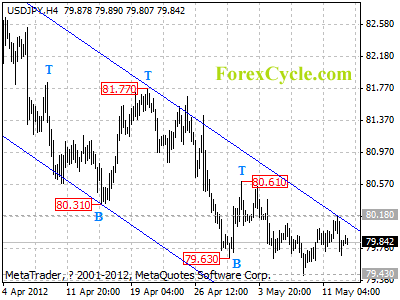London Gold Market Report
from Adrian Ash
BullionVault
Mon 14 May, 08:20 EST
THE PRICE OF GOLD and gold futures dropped yet again Monday morning, recording the seventh drop in nine trading days in May so far as industrial commodities, global stock markets and the Euro currency all sank amid Athens’ failure to negotiate a new coalition government.
Silver bullion also fell hard, touching $28.44 per ounce and losing 8.9% from the start of this month.
The price of Spanish government debt today fell yet again, pushing 10-year yields above 6.2% ahead of an auction of new bonds later today.
Greek public-sector salaries and state pensions may be unpayable “from the beginning of June” says a letter from stand-in prime minister Lukas Papadimos to party leaders, republished by Ta Nea, after May’s tranche of the international bail-out was cut and tax revenues came in below target.
“We do not think the gold bull market is over,” says a note from Morgan Stanley analysts, even though “gold has moved lower and is trading at levels not seen since December 2011.”
Viewed on a technical chart analysis, “Damage has certainly been done [but] we do not think it is irreversible,” they add, pointing to a sharp rise in speculative “short selling” by gold futures traders now expecting prices to fall further.
“The last time positioning was at these levels, prices embarked on a move higher, rallying to near $1800 per ounce. We are buyers of gold here.”
The rise in speculative short-selling of gold futures is “disconcerting” however, says Marc Ground at Standard Bank, because “while investors have over the past few weeks appeared cautious of running too short on gold, this fear seems to have evaporated.”
Over in the currency markets – where the Euro fell to new 4-month lows vs. the Dollar at $1.2860 – “We continue to target $1.20 for Euro/Dollar,” says Ground’s colleague, currency strategist Steve Barrow.
“Whether this takes time, or comes in an instant, could depend on the outcome of Greece’s political impasse.”
Energy, metal and food prices all sank once more Monday morning as European stock markets lost more than 2% of their value, with Madrid losing 3% and Athens dropping 5.3%.
At the weekend Swedish central banker Per Jansson said that “of course the question [of a Greek exit] is discussed.” Irish central bank chief, and fellow European Central Bank policymaker Patrick Honohan told journalists that “technically, it can be managed.”
“We wish it to be possible for Greece to remain in the euro but Greece must live up to its commitments,” a spokeswoman for the European Commission said Monday morning.
If Greece breaches the agreed terms of its bail-out deal then staying in the Euro would be “an impossible equation and I think in that sense it is an irresponsible statement,” said Finland’s Europe minister Alexander Stubb today about the ongoing calls for an end to cuts in Athens.
German chancellor Angela Merkel meantime suffered a drubbing in a state election on Sunday, with her Christian Democratic Union drawing only 26% of the vote in North Rhine-Westphalia, giving the coalition of Social Democrats and Greens a winning majority of 50%.
Price inflation in Germany’s wholesale markets rose sharply in April, new data showed today, while industrial production across the 17-nation Eurozone fell much harder than forecast, down 2.2% year on year.
On the FX market, the Euro today hit fresh 42-month lows vs. the British Pound, but fell less quickly than gold futures or bullion, with the gold price for Eurozone buyers slipping beneath €39,100 per kilo for the first time this year.
For Indian buyers, “The weakness of the Rupee is countering the fall in the Dollar gold price,” says Jeffrey Rhodes, global head of precious metals at INTL Commodities DMCC in Dubai, speaking to the Wall Street Journal.
“That’s likely to act as a drag on demand in the world’s biggest market.”
“There is hardly any work these days,” complains a Jaipur goldsmith to The Times of India. “First the 21-day long jewelers’ strike and now the increasing gold prices have rendered us jobless.
“It is getting tough for us to survive.”
India’s imports of gold bullion fell by two-thirds last month compared with April 2011.
Gold futures on the Multi Commodity Exchange in Mumbai today slipped back to a 5-week low, down 3.3% from early May’s new all-time highs.
Adrian Ash
BullionVault
Gold price chart, no delay | Buy gold online at live prices
Adrian Ash is head of research at BullionVault, the secure, low-cost gold and silver market for private investors online, where you can buy gold today vaulted in Zurich on $3 spreads and 0.8% dealing fees.
(c) BullionVault 2012
Please Note: This article is to inform your thinking, not lead it. Only you can decide the best place for your money, and any decision you make will put your money at risk. Information or data included here may have already been overtaken by events – and must be verified elsewhere – should you choose to act on it.

 One new option to note, iShares invests in an index of dollar bonds based on the J.P. Morgan USD Emerging Markets Bond Fund (NYSE: EMB).
One new option to note, iShares invests in an index of dollar bonds based on the J.P. Morgan USD Emerging Markets Bond Fund (NYSE: EMB).
 The benefits of preferred shares is that you get a good yield, a more secure position than common stock holders and, in these uncertain times, less risk.
The benefits of preferred shares is that you get a good yield, a more secure position than common stock holders and, in these uncertain times, less risk.



 Tradervox (Dublin) – The Euro is experiencing a huge sell off in opening trades of the week. The EUR/USD pair is on a strong bearish rally with new bearish positions building up. The trend is hugely in favor of the bears and this is adding up the bearish volatility numbers in the EUR/USD trade. The currency pair has been able to break the strong psychological support at the 1.29 level to fall further. This has added fuel to the market sentiment of shorting EUR/USD sending the pair to near 1.283 levels.
Tradervox (Dublin) – The Euro is experiencing a huge sell off in opening trades of the week. The EUR/USD pair is on a strong bearish rally with new bearish positions building up. The trend is hugely in favor of the bears and this is adding up the bearish volatility numbers in the EUR/USD trade. The currency pair has been able to break the strong psychological support at the 1.29 level to fall further. This has added fuel to the market sentiment of shorting EUR/USD sending the pair to near 1.283 levels.


